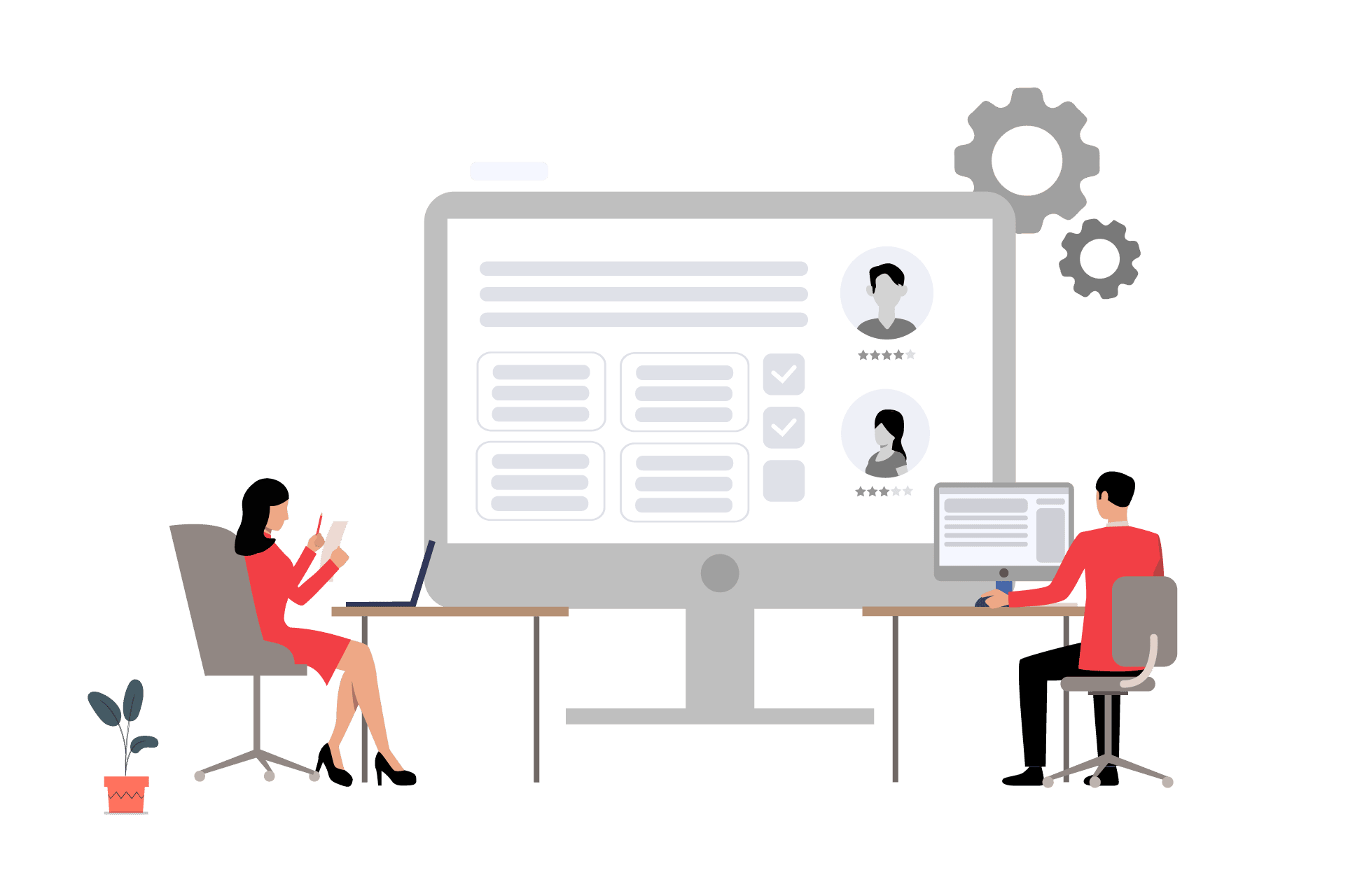In the fast-paced world of recruitment and talent acquisition, finding the right fit for your organization can be an exhilarating yet daunting journey. Every HR professional, recruiter, and founder knows that the key to success lies in identifying the best talent swiftly and accurately. This is where employment assessment tools come into play, offering the promise of streamlining the hiring process and enhancing the likelihood of finding the perfect candidate.
According to Aberdeen group, companies who use pre-hire assessment tests report a 39% lower turnover rate.
However, the abundance of choices in the assessment tool landscape can be overwhelming. To navigate this landscape effectively and make informed decisions, you need a compass to guide you through the assessment tool selection process. That’s precisely what we aim to provide in this comprehensive guide.
In the following pages, we will delve deep into the art and science of choosing the right employment assessment tools. Whether you’re a seasoned HR professional seeking to optimize your recruitment strategies, a dedicated recruiter looking to fine-tune your candidate evaluation process, or a founder determined to build a winning team from the ground up, this guide is your ultimate resource.
We will explore the various facets of assessment tools, from understanding your unique hiring needs to assessing the validity and reliability of these tools. You’ll also discover how to stay compliant with the law, while embracing diversity and inclusion, and how to seamlessly integrate these tools into your recruitment workflow.
Join us on this journey, and by the end of this guide, you’ll be equipped with the knowledge and tools necessary to choose the perfect employment assessment tools that align with your organization’s goals and values. Let’s begin the quest to unlock your organization’s full potential by identifying and nurturing the talent that can drive your success.
Understanding your needs before choosing employment assessment tools
In the world of recruitment, the adage “one size fits all” couldn’t be further from the truth. Every organization has unique hiring needs, and understanding these needs is the crucial first step in choosing the right employment assessment tools. Whether you’re an HR professional, a recruiter, or a founder, it’s imperative to consider the specific roles you’re hiring for, the industry you operate in, and the skills and attributes that hold the most significance for your organization.
Start by conducting a thorough analysis of your hiring requirements. Define the key competencies, qualities, and qualifications that are essential for success in the roles you are looking to fill. For example, if you’re recruiting for a technology startup, technical skills and problem-solving abilities might be at the top of your list. On the other hand, if your organization values a collaborative and innovative work culture, you might prioritize interpersonal skills and creativity in your assessments.
Consider the industry in which you operate. Different sectors may demand unique skill sets or qualifications. What works for a healthcare organization might not be suitable for a marketing agency. Understanding these industry-specific hiring needs is vital in selecting the right assessment tools that align with the nuances of your field.
Furthermore, take a close look at your organization’s values and culture. Do you prioritize diversity and inclusion? Are there specific values and behaviors that are crucial for your team’s success? Tailoring your assessment tools to align with your company’s culture can lead to better long-term fits and employee satisfaction.
By gaining a clear understanding of your needs, you’ll be in a prime position to select employment assessment tools that address these specific requirements. Remember, the more precise your understanding of what you’re looking for, the more effective these tools will be in helping you find the perfect candidates to drive your organization forward. In the subsequent sections of this guide, we’ll delve into the various types of assessment tools available and how they can be matched to your distinct hiring needs.
Types of assessment tools
When it comes to selecting employment assessment tools, one size does not fit all. HR professionals, recruiters, and founders should be well-versed in the various types of assessment tools available, each designed to evaluate different aspects of a candidate’s suitability for a role. Understanding the strengths and weaknesses of these tools is essential for making informed decisions in your hiring process.
Personality tests: These assessments gauge a candidate’s personality traits, values, and behaviors. They are valuable for determining cultural fit and predicting how a candidate will mesh with the existing team. However, they should be used in conjunction with other tools, as they may not provide a complete picture of a candidate’s qualifications.
Cognitive assessments: Cognitive tests measure a candidate’s mental abilities, including problem-solving, critical thinking, and decision-making skills. They are particularly useful for roles that require analytical thinking, such as data analysis or research positions.
Skills tests: These tools evaluate a candidate’s specific skills, such as coding, writing, or language proficiency. They are ideal for technical roles or positions that demand proficiency in particular areas. Skills tests can provide concrete evidence of a candidate’s abilities.
Situational judgment tests: These assessments present candidates with real-world scenarios and ask them to make decisions. They are effective at evaluating a candidate’s problem-solving skills, adaptability, and judgment. Situational judgment tests are valuable for roles that require quick thinking and sound decision-making.
By understanding these different types of assessment tools, you can tailor your selection process to the specific demands of the positions you are hiring for. A combination of these tools, used strategically at various stages of the hiring process, can provide a well-rounded evaluation of candidates, helping you make more informed decisions about who to bring on board. In the following sections, we will delve into each type of assessment tool in more detail, discussing their applications and best practices for implementation.
Validity and reliability
Choosing the right employment assessment tools isn’t just about what they measure but also how accurately and consistently they do so. In the world of assessment tools, two critical factors that should guide your selection process are validity and reliability.
Validity refers to the extent to which an assessment tool measures what it claims to measure. In the context of hiring, this means that the tool should genuinely assess the attributes, skills, or qualities that are relevant to the job in question. For example, if you’re using a cognitive assessment to evaluate problem-solving skills, it must genuinely reflect a candidate’s problem-solving abilities. Ensuring that an assessment tool has high validity is crucial to make meaningful hiring decisions. Look for tools that provide evidence of validity through research and validation studies.
Reliability is all about consistency. A reliable assessment tool produces consistent results when used repeatedly under the same conditions. In other words, if you were to assess the same candidate multiple times with the same tool, you should get similar results. This is crucial for eliminating measurement error and ensuring that your assessment tool isn’t just a matter of luck. Reliable tools can be counted on to provide accurate insights into a candidate’s abilities or characteristics.
As HR professionals, recruiters, or founders, you must prioritize both validity and reliability in your assessment tools. The tools you choose should be tailored to measure the attributes most important for the roles you’re hiring for, and they should do so consistently across all candidates. When an assessment tool possesses high validity and reliability, you can have greater confidence in the results it produces, which, in turn, enhances the overall effectiveness of your hiring process.
In the upcoming sections of this guide, we will explore how to assess the validity and reliability of different types of assessment tools and how to make well-informed decisions that enhance your recruitment and selection processes.
Compliance and diversity considerations
Ensuring that your hiring process is not only effective but also legal and inclusive is paramount in today’s professional landscape. HR professionals, recruiters, and founders must navigate the complexities of employment assessment tools while adhering to laws and promoting diversity and inclusion.
Legal compliance: Hiring processes must adhere to relevant laws and regulations, such as the Americans with Disabilities Act (ADA), Title VII of the Civil Rights Act, and the Equal Employment Opportunity Commission (EEOC) guidelines. It’s essential to ensure that the assessment tools you use do not discriminate against candidates based on protected characteristics like race, gender, age, disability, or religion. Be diligent in assessing how your chosen tools align with these legal requirements and consider seeking legal counsel when necessary to avoid potential pitfalls.
Diversity and inclusion: Beyond compliance, a commitment to diversity and inclusion is vital. Choose assessment tools that are not biased and are designed to provide equal opportunities to all candidates, regardless of their background. Look for vendors who actively address diversity concerns in their tools and provide resources for promoting inclusive hiring practices. Assess how the tools handle potential biases and whether they are designed to mitigate adverse impacts on underrepresented groups.
Balancing compliance and diversity is a delicate task, but it’s essential for creating a fair and inclusive hiring process. Your organization’s reputation and success depend on it. By considering these compliance and diversity factors when selecting employment assessment tools, you can contribute to a more equitable and welcoming workplace while reducing the risk of legal complications.
In the subsequent sections, we will explore strategies for evaluating the fairness and inclusivity of assessment tools, as well as providing guidance on the implementation of tools that align with these important considerations.
Integration and user-friendliness
Selecting the best employment assessment tools is just the beginning. To truly leverage their potential, HR professionals, recruiters, and founders need to ensure these tools integrate seamlessly into their existing recruitment processes and offer a user-friendly experience for both administrators and candidates.
Integration: Assess how well the assessment tools can be integrated with your current HR software, applicant tracking system (ATS), or other technology platforms your organization uses. A lack of integration can lead to manual data entry, data discrepancies, and a less efficient recruitment process. Look for tools that offer APIs or built-in integrations to streamline data transfer and reporting.
User-friendliness: An assessment tool should not be a source of frustration for either your HR team or the candidates being assessed. Consider the ease of setup, administration, and reporting. User-friendly tools make it simpler to onboard and train your HR team, and they also create a more positive experience for candidates. Tools with clear instructions, intuitive interfaces, and accessible support options can enhance the overall assessment process.
Candidate experience: The candidate’s experience with the assessment tool is equally important. Tools should be candidate-friendly, providing clear instructions and a smooth, hassle-free process. Complicated or time-consuming assessments can discourage top talent from completing the application process. Remember, the assessment process often serves as the candidate’s first real interaction with your organization, and a positive experience can leave a lasting impression.
By evaluating the integration capabilities, user-friendliness, and candidate experience, you can make sure that the assessment tools you choose not only meet your hiring needs but also enhance the efficiency and effectiveness of your recruitment process. In the following sections, we will dive deeper into the practical aspects of implementing and using assessment tools, providing insights into best practices and considerations for creating a seamless and user-friendly experience for all stakeholders involved.
Conclusion
In the ever-evolving landscape of talent acquisition, the art and science of hiring have taken on a new dimension. As HR professionals, recruiters, and founders, your quest for the perfect hire is both exhilarating and challenging. Employment assessment tools have emerged as invaluable allies in this quest, promising to streamline your hiring process and, ultimately, find that perfect candidate who can drive your organization’s success.
However, as we’ve explored throughout this guide, choosing the right employment assessment tools is a journey in itself. It begins with understanding your unique needs and the intricacies of the roles you aim to fill. These needs define the roadmap for your assessment strategy. You’ve learned that there’s no one-size-fits-all solution, and your toolbox should contain a variety of assessment types, each designed to reveal different facets of a candidate’s potential.
You’ve delved into the crucial concepts of validity and reliability, recognizing that the ability of assessment tools to measure what they claim, consistently and accurately, is paramount. Beyond that, legal compliance and diversity considerations underscore your ethical responsibility, as well as the legal consequences, in the hiring process.
And then, you’ve explored the practical side of assessment tools: how they integrate into your existing systems, the ease with which they can be administered, and the experience they offer to both your HR team and your candidates. User-friendly tools that integrate seamlessly into your workflow can make the difference between a laborious process and an efficient, productive one.
In closing, remember that the journey doesn’t end with the selection of the right assessment tools. It continues through their careful implementation, ongoing evaluation, and adjustment. The path to perfect hires is dynamic, and it calls for adaptability and continual learning.
By adhering to the principles and best practices outlined in this guide, you are poised to make well-informed decisions that can enhance your recruitment process and, ultimately, lead you to the talent that will shape your organization’s future. As you embark on your journey to unlock the full potential of your workforce, remember that the right assessment tools are more than tools; they are the compass that guides you toward the extraordinary talent that awaits. Happy hiring!
Are you tired of bad hires and really want to get a top talent this hiring season for your team? Don’t worry, we got you covered. Sign up with us for free and check out testlify’s test library that contains over 1400+ on the job skills test.








